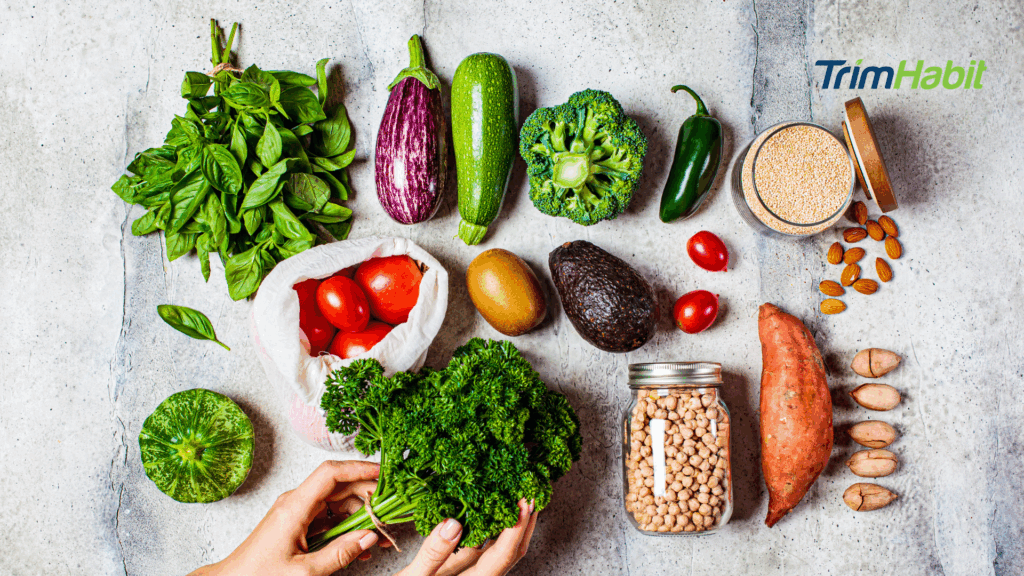Whey and chicken are both excellent sources of protein that you can eat. Even though they are similar in some ways, they are very different in how they are prepared, digested, and absorbed. Whether you choose to eat one or the other, or both, depends on your health goals, lifestyle, bodily functions, and personal preferences.
Keep reading this article to explore the comparison between whey protein vs chicken for weight loss, including the nutritional content of each, their potential benefits, and side effects.
Nutritional Content
Choosing the right protein source is essential for meeting your nutritional needs and achieving specific health goals. When it comes to protein-rich options, whey protein and chicken are two common choices.
Using the latest data from NIH and USDA, here is a comparison of the nutritional value of 100 grams of cooked chicken breast and whey protein powder1.
- Whey protein powder and chicken breast are high in calories, potassium, and protein.
- Chicken breast has more DHA than whey protein powder regarding omega-3 fatty acids.
- Chicken breast has 4.3 times less fat than whey protein powder.
- Thiamin, riboflavin, folate, and Vitamin B12 are more abundant in whey protein powder, but chicken breast has more niacin and pantothenic acid.
- Calcium and fiber are both found in good amounts in whey protein powder.
Whey Protein For Weight Loss
Whey protein is a supplement often used in conjunction with resistance training to enhance muscle protein synthesis and promote the development of lean muscle mass. It offers several potential benefits, including assistance with weight loss and reduction of cholesterol levels.
Derived from the liquid part of milk that separates during cheese production, whey protein is a combination of proteins. Approximately 80% of the protein in milk is casein, while the remaining 20% is whey. The whey component is primarily found in the watery portion of milk. In the cheese-making process, the fatty parts of milk coagulate, leading to the separation of whey2. In the past, cheesemakers used to discard whey before realizing its economic value.
After being removed from cheese, whey undergoes several processing steps to transform into whey protein powder. This powder is then added to whey protein shakes, meal replacements, and protein bars.
Benefits Of Whey Protein
The health benefits of whey protein are numerous and varied. Here are the many benefits it can offer:
Excellent Source Of High-Quality Protein
Milk protein is the name for the protein in milk. It has all the necessary amino acids and is a complete protein. Also, it is easy to digest and quickly taken by your body compared to other types of protein3.
Because of these things, it is one of the best food proteins.
Three main kinds of protein powder are made from whey: concentrate, separate, and hydrolysate (WPC, WPI, and WPH).
May Promotes Muscle Growth
Muscle strength naturally goes down as you get older. Most of the time, this makes you gain weight and increases your risk of many long-term illnesses.
But this change in your body makeup can be slowed down, stopped, or even turned around in part with strength training and a healthy diet.
Strength training and high-protein foods or protein pills are good ways to avoid injury4.
Whey and other high-quality protein sources are particularly effective in supporting various physiological processes and meeting the body’s protein needs. These proteins are known for their excellent amino acid profile, which includes a rich concentration of essential amino acids necessary for muscle protein synthesis, tissue repair, and overall growth and maintenance of the body.
Whey has a lot of leucine, which is a branched-chain amino acid. Leucine is the amino acid that helps people grow the most5.
Because of this, whey protein is good for preventing muscle loss that comes with age and for making you stronger.
May Lower Blood Pressure
Hypertension, or blood pressure that is too high, is one of the leading causes of heart disease.
Several studies have found a link between eating dairy products and having lower blood pressure6,7,8,9.
Some bioactive peptides in cheese, called angiotensin-converting-enzyme inhibitors (ACE inhibitors), are thought to be responsible for this effect10,11,12.
Lactokinins derived from whey proteins have been found to exhibit ACE inhibitory activity, potentially contributing to their positive effects on blood pressure regulation13,14,15.
May Help Treat Type 2 Diabetes
Type 2 diabetes is a long-term disease marked by high blood sugar and insulin that doesn’t work as well as it should.
Insulin is a hormone meant to make cells take in sugar from the blood and keep the sugar in the blood within healthy limits.
Whey protein has been shown to help control blood sugar by making the body more sensitive to insulin and making insulin levels rise16,17,18,19.
May Help Reduce Inflammation
When the body is hurt, inflammation is one way it tries to heal itself. Short-term inflammation can be helpful, but in some cases, it can last for a long time.
Chronic inflammation can be harmful, and it puts you at risk for a lot of different illnesses. It could be a sign of a health problem or bad habits hurting your health.
A large review study found that high doses of whey protein supplements (greater than or equal to 20 grams/day) cut C-reactive protein (CRP), a key marker of inflammation in the body, by a lot20.
May Be Beneficial For Inflammatory Bowel Disease
Inflammatory bowel disease (IBD) is a condition in which the lining of the digestive system stays inflamed for a long time. It refers to Crohn’s disease and ulcerative colitis as a whole.
The use of whey protein supplements has been shown to help IBD in both animals and people21,22.
May Enhance The Body’s Antioxidant Defenses
Antioxidants are things that stop the body from oxidizing. This means they lower the chance of oxidative stress and several chronic diseases.
Glutathione is one of the most essential vitamins in people. Your body makes glutathione, while most antioxidants come from your food.
The body makes glutathione with enough specific amino acids, like cysteine, which is sometimes in short supply.
Because of this, foods like whey protein that is high in cysteine may help the body’s antioxidant defenses23.
Side Effects Of Whey Protein
Whey protein is a popular supplement for athletes and people who want to build muscle growth. Aside from all the health benefits, there is also some debate about its safety.
Based on facts, this piece looks at whey protein’s safety and side effects.
May Cause Digestive Issues
Several known side effects of whey protein have to do with how it is digested. Some people may have these side effects because they can’t handle lactose.
Some people can’t break down lactose well, which can lead to signs like bloating, gas, stomach cramps, and diarrhea.
In many whey protein products, lactose is the main carbohydrate.
People who can’t process lactose well don’t make enough of the enzyme lactase. Your body needs lactase to break down lactose. Lactose intolerance is prevalent; up to 65% of the world’s population can have it24.
If you can’t handle lactose, use whey protein isolate instead of whey protein concentrate.
May Be Allergic To Whey Protein
Since cow’s milk is where whey protein comes from, people who are allergic to cow’s milk can also be allergic to it. People allergic to cow’s milk are usually told to avoid food like whey protein.
Cow milk allergy is relatively common in kids. About 2% to 4% of kids younger than three years old have it. But people are less likely to have it. About 80% of people allergic to cow’s milk grow out of it by age 16.
Cow milk allergies can cause hives, rashes, swelling of the face, mouth, and tongue, and a runny or stuffy nose25.
An allergy to cow’s milk can sometimes cause anaphylaxis, a serious allergic reaction that can kill you. If you have a severe allergic response, your lips, tongue, or throat might swell, or you might have trouble breathing. Get medical help right away if you think you are having a severe allergic response.
Chicken For Weight Loss
Chicken is a popular meat that is eaten all over the world. It is known for being easy to use in various cuisines and meals.
Chicken is a popular food that can be cooked in many different ways. It can be roasted, grilled, fried, or baked. But chicken is also good for your health, especially when helping you lose weight.
Benefits Of Chicken
Health nuts and people who work out a lot have preferred chicken as a regular food for a long time. One of the most talked-about benefits of eating chicken is that it can help you lose weight, but it can also benefit you in other aspects. The benefits of chicken include:
High Protein Content
Adding chicken to a healthy diet as a source of protein can be very helpful.
Studies have shown that chicken can contribute to providing energy for the body. One hundred grams of raw chicken has 21.5 grams of protein26.
Protein makes you feel fuller for longer, speeds up your metabolism, and helps your body heal after a workout.
When combined with strengthening activities and resistance training, protein also helps muscles grow, which increases the number of calories burned at rest. It makes chicken an important part of a meal for getting stronger.
Less Fat And Cholesterol
Research shows that chicken is better than red meat because it has less saturated fat and cholesterol. This can be attributed to the fact that chicken, particularly lean cuts like skinless chicken breast, is typically lower in fat content. Reducing saturated fat and cholesterol intake is often recommended as part of a heart-healthy diet, as high levels of these substances have been associated with an increased risk of cardiovascular diseases. Choosing organic and natural chicken is important to avoid dangerous chemicals and additives27.
Low In Calories
The low number of calories in chicken is another reason why it helps people lose weight. A study says that keeping a calorie balance is important if you want to lose weight. It means that you use up more calories than you eat. One hundred grams of raw chicken without the skin has only 120 calories, so it’s a great choice for people who want to lose weight28.
Other Benefits
In addition to being low in calories and high in protein, chicken has other benefits that can help you lose weight. Worrying can cause people to overeat and eat foods high in calories, fat, or sugar. It also makes people less active and makes them sleep less.
There are many vitamins and minerals in chicken that can help relieve premenstrual symptoms and lower stress. It is especially rich in selenium, niacin, and phosphorus, which can help you control your weight and improve your general health29.
To help you healthily lose weight, a healthy plate of food must have chicken and lean meat. To build bigger muscles, you must eat right after a workout. To lose weight and build muscle, you must eat a healthy diet with the right amount of amino acids, vitamins, and minerals and work out regularly.
Chicken is a good choice for people trying to lose weight because it is low in calories and high in healthy nutrients that help people lose weight. Also, eating chicken often can make your bones stronger, decrease your hunger, and build muscle mass.
Side Effects Of Chicken
Even though chicken is considered healthy because it has a lot of nutrients, eating it every day has several negative effects. Here’s how:
May Increase Your Cholesterol Levels
A small study released in the American Journal of Clinical Nutrition found that chicken white meat raised “bad” LDL cholesterol levels like red meat. This can also make you more likely to get heart problems30.
Poultry Pathogens
The Centers for Disease Control and Prevention say that about 1 million people die yearly from eating poultry with harmful germs. A study done in 2017 found that chicken was responsible for the most foodborne outbreaks, illnesses, hospitalizations, and deaths31.
Since 2013, most foodborne cases have been caused by Campylobacter32, which can cause diarrhea that is sometimes bloody and sends 18% of people to the hospital.
Choosing Whey Protein Vs Chicken For Weight Loss
When considering whey protein and chicken to help you lose weight, there are a few things to remember. These are a few essential points:
Convenience
Preparing chicken requires cooking and can take some time, especially if cooking a whole chicken or using a slow cooking method. On the other hand, whey protein is highly convenient as it comes in powder form and can be quickly mixed with water or other liquids. This convenience factor makes it easier to incorporate protein into your diet, especially when you’re short on time.
Nutrient Profile
While both whey protein and chicken are good protein sources, chicken offers additional nutrients like vitamins, minerals, and healthy fats. It also provides essential amino acids that support overall health and well-being. On the other hand, whey protein is generally low in fat and carbohydrates, making it a lean protein source.
Satiety and Digestion
Whole food protein, like chicken, generally provides more satiety than liquid supplements like whey protein. Chewing and digesting solid food can help you feel more satisfied after a meal. However, whey protein can still be satisfying due to its high protein content, and it can be helpful for quick and convenient post-workout nutrition.
Personal Preference
Personal preference and dietary restrictions should also be taken into account. Some people may have dietary restrictions or allergies that prevent them from consuming chicken, while others may prefer plant-based protein sources. Whey protein is derived from milk, so it may not be suitable for lactose intolerant or following a vegan or dairy-free diet.
Summary
Whey protein is a complete protein that promotes muscle growth, lowers blood pressure, helps manage type 2 diabetes, reduces inflammation, and supports antioxidant defenses. However, it may cause digestive issues and allergic reactions in some individuals.
Chicken is also high in protein, low in calories, and can aid in weight loss. It provides additional nutrients and offers satiety but may increase cholesterol levels and pose risks of foodborne illnesses.
The choice between whey protein and chicken depends on convenience, nutrient profile, satiety, digestion preferences, and potential side effects.
Citations
1 U.S. Department of Agriculture, Agricultural Research Service. 2022. USDA Food and Nutrient Database for Dietary Studies 2019-2020. Food Surveys Research Group Home Page, http://www.ars.usda.gov/nea/bhnrc/fsrg









